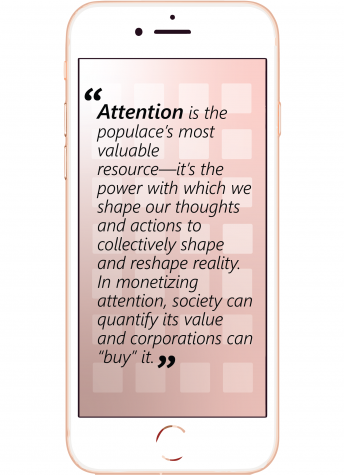We are perpetually distracted. Gathered for meals, my friends and I often place our screens into a pile atop the table, vowing the first person to touch their phone pays for the meal. 30 minutes later, we all give up. Much of our conversation revolves around the screens and memes shared online, and the frequent dopamine boosts from our buzzing devices is too tempting to resist. Who can blame us?
Yet, the proliferation and minute differentiation of social media platforms begs the question—do we need all this? The American public is no stranger to social media—73 percent of adults use YouTube and 69 percent use Facebook. Our societal consciousness is influenced by and reflected in social media engagements. Privacy and personal reflection are key to healthy identity development. However, due to advance tech monitoring, privacy is often readily surrendered and not easily won. 5G internet connectivity may make anonymity a relic of the analog age. Corporations design addictive social media layouts to maximize user attention backed by neuroscience principles. These designs adversely affect modern communication and connection.
Attention is the populace’s most valuable resource—it’s the power with which we shape our thoughts and actions to collectively shape and reshape reality. In monetizing attention, society can quantify its value and corporations can “buy” it.
So, a market need arose to design apps with express intent to increase time spent on platforms. Companies formed to fulfill that need. Corporations created algorithms to curate news feeds and posts reflective of consumers’ demonstrated interests. A subset of these companies employs neuroscience principles to exploit psychological vulnerabilities. One company, Boundless AI, outrightly purports to “predictably change your users’ behavior with AI.”
Technologists, especially those working with artificial intelligence (AI), often wield some power over the public. Corporations, like Boundless AI, harness this power to covertly manipulate consumers’ social media experiences. These practices capture consumers’ attention and exploit it for financial gain.
Analyzing this issue raises questions regarding the value of consumer attention and the responsibility of corporations to create conditions maximizing users’ happiness and success. Social media platforms facilitate instant communication on an unprecedented scale. What unprecedented responsibilities do these companies have to consider the wellbeing of their consumers, and design products accordingly?
Social media corporations have not had to answer for their apps’ intentionally addictive designs. The topic, if brought to public consciousness, would compromise large revenue streams for social media companies and for individuals and corporations who monetize or advertise content. The reputation of social media companies—staples in the modern communication ecosystem—would be further damaged.
With little awareness of this issue in the public consciousness, the citizenry cannot debate and correct our collective decision-making to shape a more ethical, mutually-beneficial society. With an incomplete understanding of how social media platforms are manipulated, individuals cannot draw accurate conclusions or make well-informed decisions. Yet, with dogged media coverage, the public can be equipped with tools to debate. We can decide, as a community of digital users, how exploiting psychological vulnerabilities of an unwitting public for the financial gain of a few aligns with our shared values.
Modern distraction culture is no accident. It is the byproduct of intentional, systemic efforts to monopolize attention. As a digital native, social media facilitates, to a large degree, my peer communication and connection. The failure of social media corporations to curb platform addiction adversely affects much of my social communications. Addictive social media platforms draw unsuspecting users away from valuable in-person connection, thus impeding opportunities for meaningful offline connection.
My generation has been shaped, in large part, by technological advancement pioneered by previous generations. As young people assume leadership positions, we will have the agency and online prowess to equitably reshape the digital landscape—creating increased opportunities for meaningful connection mindful of humanity’s psychological vulnerabilities. We’ll transform the burdens of constant connectivity into boons—equipping everyone with the tools and knowledge to realize dreams, incite social change and deepen shared human experiences through the World Wide Web.
